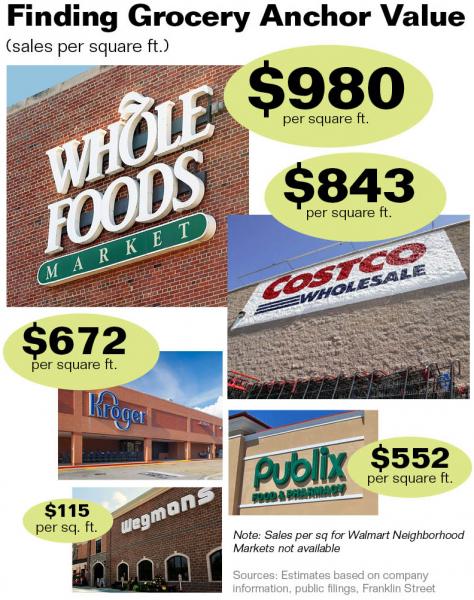Grocery chains might look like they have it easier than apparel retailers. They fall under the “necessity retail” grouping, after all, and which household doesn’t need to stock up on everything from paper goods to produce regularly?
But almost every aspect of consumer taste and buying habits is shifting and savvy grocery store operators know that selling a plum needs to be handled with the same aplomb as moving clothes and accessories. Success isn’t guaranteed just because consumers spent $100.8 per week on groceries in 2015, according to data reported by Statista.com. The fact is that grocery spending in that year was off its peak from $105.5 in 2013.
From a real estate investor’s perspective, desirable grocery chains should consistently drive heavy foot traffic to their shopping center, have at least 15 to 20 years left on their lease terms, and regularly increase their sales per sq. ft., according to industry observers.
The grocery business is currently fragmented, one where operators dominate by region and few national operators eclipse other supermarket chains in their footprints.
“Investors source and seek out the top three operators in a local market,” says Bill Rose, a vice president and national director of retail with brokerage firm Marcus & Millichap.
By year-end 2015, grocery-anchored shopping centers traded at an average cap rate of roughly 7.0 percent, after about five years of slow and steady tightening, according to data from Marcus & Millichap Research Services and New York City-based research firm Real Capital Analytics (RCA). In the first quarter of 2016, cap rates on single-tenant net leased properties occupied by grocery stores compressed to 5.25 percent, said John Feeney, vice president at The Boulder Group, a net lease commercial real estate firm, in an emailed response.
“This was greater than the 7 basis points the entire retail sector experienced during the same time period,” Feeney said.
So which grocery chain operators are finding favor with investors? It all depends on the specific market where an investor is hoping to buy a retail property, observers say.
Setting a national standard
All grocery store operators need to understand what is most important to their core customers and makes the shopping experience appealing for them, whether they operate as strip center anchors or as stand-alone stores.
“The ability to differentiate offerings from one store to the next, where the products are customized to local needs, is a big deal,” says George Pandaleon, president of Inland Institutional Capital Partners, an Oak Brook, Ill.-based real estate investment and asset manager.
The Kroger Co. has been particularly successful at that, in part by acquiring top local operators. Last December, for instance, it bought Milwaukee-based Roundy’s Supermarkets, Inc., a supermarket company comprised of four brands, in a deal worth $800 million. The transaction was expected to make Kroger the number one grocery operator in the Milwaukee area, and it added the Mariano’s brand to its portfolio, a top grocer with 34 locations in Chicago.
Kroger is just one of several top grocers that have figured out how to appeal to local shoppers while succeeding on a national scale. Whole Foods Market and Costco Wholesale are two other examples. For its part, Whole Foods focuses on delivering organic foods while supporting the environment, acquiring foods in an intelligent way and committing to paying its workers living wages. For Costco, the warehouse club format is more than just about a large space where patrons pick through bins to find what they need.
“It is a bit of a treasure hunt,” Pandaleon says. “The experience is becoming more and more valued by the consumer, as opposed to just getting what they need. A lot of retailers are finding ways to keep the customers in the store longer, for that matter.”
North and South: Where service inspires envy
In the Northeast, foodies either devotedly shop their local Wegmans store or longingly wait for news of an opening near them, if they do not live within easy reach of a location.
“Wegmans has created a really positive environment,” Pandaleon says of the Rochester, N.Y.-based chain with 88 stores from New York to Virginia. “The service level is high and the employees are well trained. They create an experience for you.”
Throughout the Southeast, shoppers have many options, but the most outstanding name is Publix Supermarkets.
“Publix is phenomenal in the Southeast,” says Rose.


